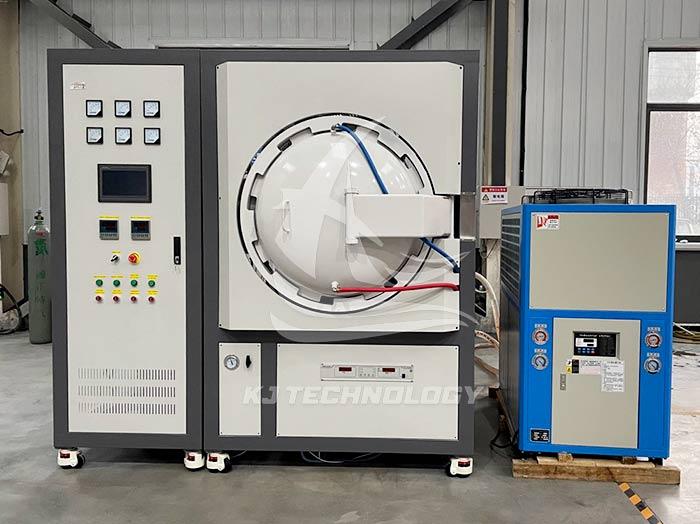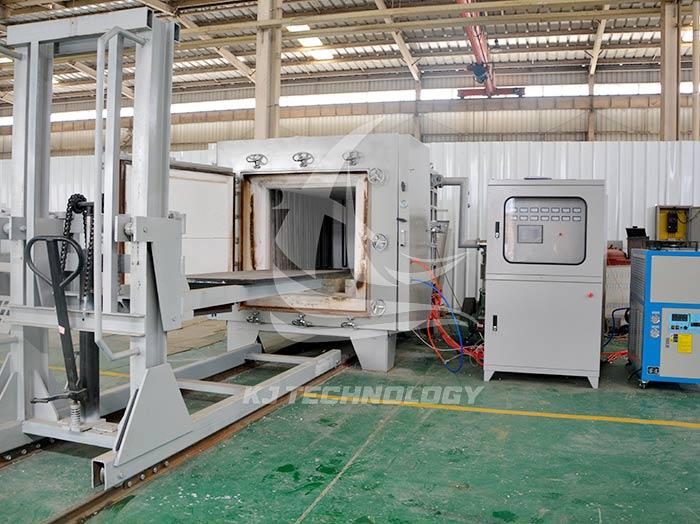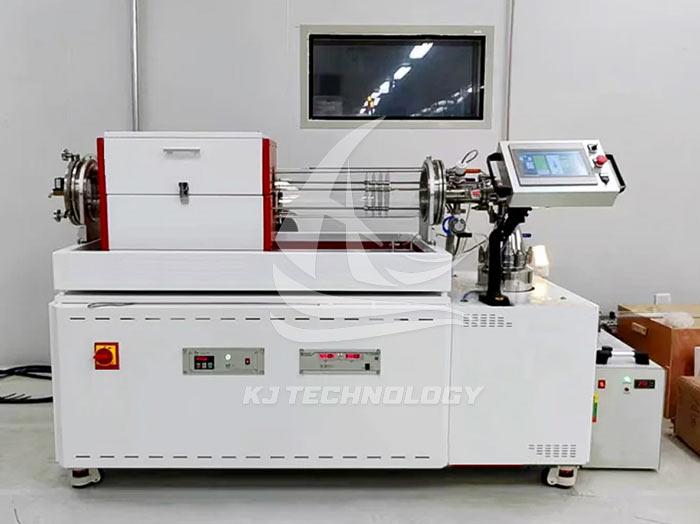Daily maintenance of pressure sintering furnace
 07-09-2025 Author: KJ technology
07-09-2025 Author: KJ technology
As a key equipment in high-temperature and high-pressure environments, the daily maintenance of pressure sintering furnaces is directly related to the stability of equipment performance, service life, and production safety. The following outlines the key points of daily maintenance from seven aspects: cleaning and maintenance, seal inspection, electrical system maintenance, cooling system maintenance, lubrication and maintenance of moving parts, verification of safety accessories, operation records, and fault prevention.
1. Cleaning and maintenance: prevent pollution and corrosion
Internal cleaning of furnace body
Daily cleaning: After each sintering is completed, wait for the furnace temperature to drop below 100 ℃ and use specialized tools (such as graphite brushes, vacuum cleaners) to clean the residue inside the furnace, avoiding carbides or metal oxides from adhering to the heating elements or furnace walls.
Deep cleaning: Wipe the inner wall of the furnace and the surface of the heating element with alcohol or acetone every week to remove oil stains or organic residue, and prevent corrosive gases from decomposing at high temperatures.
Refractory material inspection: Check the refractory materials (such as alumina fiberboard) in the furnace every month for cracking or detachment, and repair or replace them in a timely manner to ensure thermal insulation performance.
external cleaning
Wipe the furnace shell with a dry cloth, avoid using corrosive cleaning agents, and prevent damage to the surface coating.
Regularly clean the dust from the cooling holes of the control cabinet to ensure good heat dissipation of electrical components.
2. Seal inspection: Ensure vacuum and pressure stability
Sealing ring replacement cycle
Furnace door sealing ring: Check once every 3 months. If hardening, cracking, or compression deformation exceeds 20%, replace immediately.
Pipeline connection sealing components: Check once every 6 months, with a focus on inspecting the O-ring or flange gasket of the vacuum pipeline and gas filling valve to prevent air leakage that may cause a decrease in vacuum degree or atmosphere pollution.
Sealing test
Conduct a pressure maintenance test once a month: close the furnace door and vacuum it to ≤ 5Pa, observe the pressure rise within 30 minutes. If it exceeds 10Pa, check for leaks in the sealing components or furnace body.
3. Electrical system maintenance: prevent short circuits and signal interference
Wiring Tightening Inspection
Every quarter, use a wrench to check whether the wiring terminals inside the control cabinet are loose, with a focus on inspecting the wiring of heating elements, temperature sensors, and pressure transmitters to avoid poor contact that may cause signal errors or equipment shutdown.
Dust removal for electrical components
Every six months, use compressed air to blow away dust on the surfaces of relays, contactors, PLC modules, and other components inside the control cabinet to prevent insulation performance degradation or short circuits caused by dust accumulation.
Grounding resistance detection
Every year, use a grounding resistance tester to test the grounding resistance of the equipment, ensuring it is ≤ 4 Ω, to prevent safety accidents caused by leakage.
4. Cooling system maintenance: ensuring the continuous operation capability of equipment
Cooling water quality management
Use deionized water or softened water as the cooling medium, and regularly test the water conductivity (should be ≤ 10 μ S/cm) to prevent scale from blocking the cooling pipeline.
Replace the cooling water once every quarter and clean the water tank and filter to remove impurities.
Inspection of water pump and radiator
Check the sound and flow rate of the water pump every month. If there is abnormal noise or a decrease in flow rate, disassemble and clean the impeller or replace the water pump.
Clean the dust on the surface of the radiator every week to ensure heat dissipation efficiency and avoid overheating and damage to the heating element due to insufficient cooling.
5. Lubrication and maintenance of moving parts: reducing wear and sticking
Guide rail lubrication
Apply high-temperature resistant grease (such as molybdenum disulfide grease) to the furnace door guide rail every month to ensure smooth opening and closing and reduce friction and wear.
Hydraulic system maintenance
Check the hydraulic oil level and quality every quarter. If the oil turns black or exceeds the water content limit (determined by a moisture detector), replace the hydraulic oil and clean the oil tank.
Replace the hydraulic system filter element once a year to prevent impurities from entering the oil cylinder and causing damage to the seals.
6. Safety accessory verification: Ensure reliable overpressure and overtemperature protection
Calibration of pressure gauge and safety valve
The pressure gauge should be sent to the metrology department for calibration every six months to ensure accurate range (error ≤ ± 1.6%).
The safety valve should be manually opened once a year to check if the pressure relief function is normal. If it cannot be opened normally, it needs to be replaced.
Temperature sensor calibration
Calibrate thermocouples quarterly using a standard temperature source (such as a dry well temperature calibrator) to ensure measurement error of ≤± 0.5 ℃ and prevent sintering process deviations caused by temperature distortion.
7. Operation records and fault prevention: establishing a data-driven maintenance system
Running parameter record
Record key parameters such as sintering temperature, pressure, and vacuum degree daily, draw trend charts, and analyze changes in equipment performance.
Record the usage time of the heating element. If a single element has been used for more than 2000 hours cumulatively, it is necessary to focus on monitoring its resistance value changes to prevent open circuit faults.
Spare parts inventory management
Reserve commonly used spare parts (such as sealing rings, thermocouples, heating elements), establish inventory records, and ensure quick replacement in case of failure.
Regularly inventory spare parts and use vulnerable parts (such as sealing rings) according to the "first in, first out" principle to avoid aging and failure.








